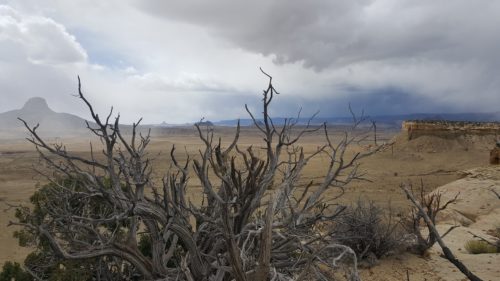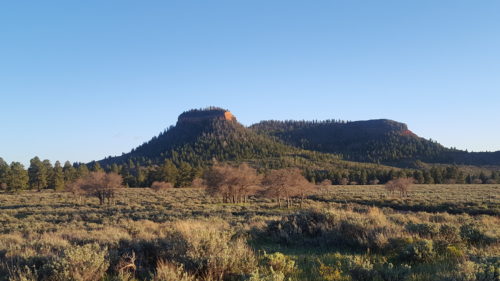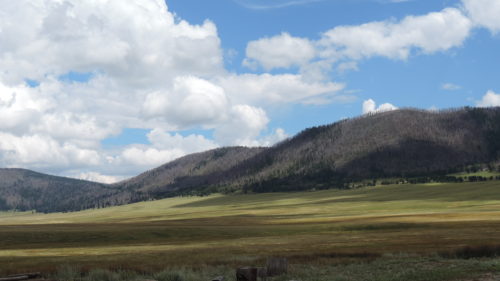The most recent meeting of the New Mexico Department of Game and Fish started off on a positive note by recognizing the hard work of the department staff putting on the Outdoor Expo in Albuquerque over the weekend of August 20th. Director Alexa Sandoval applauded the staff for their phenomenal effort and noted that attendance increases every year.
Next, the commission got right down to business with a presentation from the State Land Office on progress made since the previous meeting. Updates since the previous meeting included addressing the posting of signs on SLO properties, and that the lease is basically the same as last year but this one will apply for three years. The SLO seemed confident this plan will be pushed forward for approval.
Commission Ralph Ramos took the opportunity to express “disappointment” about the landlocked issue and hopes a discussion will continue about how to get hunters into these areas that currently have no access. Commission Ramos expressed his desire to see more information on the SLO website about access and that he will “keep harping on” this issue. He added that he was glad to see the signs but that the lease is right where we were last year and that it’s “business as usual” adding “I’m the only commissioner who voted against that high fee, and unless we keep working with sportsmen I think that’s where my vote is going to stand.”
An officer from the Department of Game and Fish chimed in to say that as landlocked issues come up they’ve been working with SLO to get some of them open, but it takes the work of both departments. Chairman Paul Kienzle asked for clarification on how much landlocked areas there actually are, to which the officers responded they weren’t sure of the exact number but a mapping process is ongoing. Chairman Kienzle emphasized that it’s important for us to understand the magnitude of this issue and that the issue will be revisited at the next meeting.
Commissioner Ramos spoke up again saying that he would like more transparency and the feedback of the public and especially sportsmen. Commissioner Ramos highlighted that sportsmen’s experiences could be a real eye-opener as to where these places are. He encouraged seeking out private landowners and figuring out what we can do to get more access and threw out the idea of special tags. He again called for “out of the box thinking” and reminded everyone that sportsmen are paying a million dollars every year but still don’t have access to many of these lands.
Commissioner Robert Espinoza asked about the current state of the process of putting signs up at access points, and asked for pictures of the signs at the next meeting. He added that he knew of landowners locking gates and blocking sections of public land. He said he was okay with gates being locked for valid reasons, but if a gate is “locked to just to lock it” he disagreed with that and emphasized that we need to work together to keep gates opened.
Commissioners Bill Montoya and Bob Ricklefs questioned how much time the department officers spend on SLO land. A different SLO officer came forward and gave some more insight into the current state of mapping saying that they’ve been working to get camp signs up and put in GPS locations for these areas. They’re working with the Department of Game and Fish to put up more signs provided by the department. After some signs went up they got calls from local departments asking for me which the office says “they applaud.” SLO assured the commission that as GPS locations increase they’ll need to work together to get access to those landlocked areas. He added that SLO would love to engage in more conservations and possibly put some permits on private and public land, but the intention is to work together.
Commissioner Dick Salopek asked about the coordination was being done with the Bureau of Land Management, as some of the landlocked areas might not necessarily be private land. SLO responded to the commission by saying that coordination is exactly what needs to happen to make sure access is reasonable for hunters, anglers, and trappers of the state.
Commissioner Ramos spoke up again expressing his appreciation for the information shared and voiced his respect for the officers out in the field as they have a very important role. He then asked about the protocol for someone locking a gate and if it’s possible to revoke their lease – on the extreme end of the scale. He concluded by saying he wants all these places to be family friendly and a safe environment.
The SLO responded by saying the steps now being taken are addressing this issue, whereas before there wasn’t communication and you didn’t find out gates were closed until later. Without cooperation we’ll have the same issues we had last year, but now there are dots and access points that we agree on.
Commissioners Kienzle and Ramos both agreed that more public education is needed, with Chairman Kienzle suggesting to add a line in the handbook about checking and scouting to see if gates are open before going out to hunt. Chairman Kienzle added that he thinks we’re moving in the right direction and we’re having a constructive conversation.
Our president John Crenshaw spoke during the public comment session saying, “I’ll be uncharacteristically brief, it’s no secret we were not very happy as an organization with the price that we got, it is heartening to see significant progress on some of the commitments that were made by both agencies to assure access and to monitor it and to keep that going. Hunting season is just about to start and we will be watching and I’m sure we will be hearing if anything goes wrong.”
After revocations, the commission moved on to the issue of technology use while hunting. This was a continuation of an agenda item from the previous meeting and it dealt with fair chase and using trail cameras and wi-fi enabled devices for hunting. Officer Robert Griego highlighted that they know “without a doubt” that there is an issue with real time cameras but the issue is to make sure the rules implemented are enforceable.
Commissioner Ramos once again voiced his opinion against the use of real time cameras and the need to ensure a fair chase. Saying, “When someone goes out there and uses the trails and uses their skills that’s fair chase.”
Officer Griego agreed with Commissioner Ramos’ sentiment but again echoed the difficulty of regulation. The amount of lag time between when a picture is taken and when an animal is harvested is an especially difficult sticking point.
Commission Espinoza questioned the limits of when we’ll stop regulating. He pointed out that technology evolves quickly and there are some technologies that are helpful and make people better and more ethical hunters and that he’s opposed to over regulating and more rules. He pointed out that the officers “already have their hands full” enforcing current rules and would rather the officers focus on hunters harvesting elk out of season. Commissioner Montoya questioned the pervasiveness of the problem, and also worried about the ability of law enforcement staff to enforce another law.
The issue concluded with the officers informing everyone they’re drafting a statement about fair chase and technology for everyone’s use.
The next agenda item touched on a similar issue, the use of magnification on archery equipment. Ty Jackson presented his findings that they are prohibited in 4 states, and 24 states out of 28 he spoke with allow them or don’t have a rule against them. Jackson identified the outcomes of changing the role as allowing archers with imperfect vision to improve their aim without “fundamentally changing the primitive nature” of bow hunting. He also emphasized that with better vision for hunters there could be fewer wounded animals.
Commissioner Ramos spoke up again and asked why there would be a limit on clarifiers for archers when other weapons don’t have the same restrictions. He said he would “advocate for bow hunters” by asking for the same opportunity for fair chase and ethical kills for bow hunters that snipers have. Commissioner Ramos’ main point could be distilled to wanting to keep everything fair across the whole board.
Jackson responded by saying that this issue goes back to our last discussion about fair chase, and that the department is going to keep revisiting it. As technology advances we need to develop rules to make hunting more ethical, and laws that make the most sense and stay ever evolving.
Commissioner Espinoza added that this is an example of making hunters more ethical in their kills, and this is one instance that proves technology can help. He encouraged the department to see if there are other rules that are illegal right now but that would make hunters more ethical that we should look into those as well.
Director Alexa Sandoval assured the commission that more information would be available for the next meeting.
The next issue was a rather complicated one that involved proposed updates to E-tags for big game and turkey hunts. The pros of the current system, as presented by Officer Robert Griego, where hunters print their licenses at home include convenience and ease of printing additional licenses if one is lost. However, that ease of printing is the main “con” of the current system where some hunters are taking advantage of the system and printing as many licenses as they want and carcass tags are uncontrollable. Additionally, even with the ease of use of printing at home, officers are finding hunters in the field who do not have their license on them.
The proposal put forth take a stab at addressing many of the issues the department has dealt with over many, many years and a sampling of how they can be addressed. The changes proposed include keeping the online selling of licenses as well as over the counter at designated shops, having a private vendor print and mail carcass tags to all the hunters who draw tags, and to stop the selling of online licenses 10 – 14 days prior to the hunt. The carcass tags will be linked to specific license numbers so the officers in the field can tell if the carcass tag is valid or not.
The proposed tag would have three portions, a donation, antler, and carcass tag of which the carcass tag would need to be attached to the kill. The antler tag would need to be notched if the antlers are separated. This proposal would allow for the hunter to authorize the transportation of the carcass to someone else who could take your harvested animal into town for you.
Officer Griego continued by saying that after speaking with our sportsmen, the department learned sportsmen like having a carcass tag, they think it’s easy to understand and they know when they harvest an animal they tag it and that they like the system. “We want out sportsmen to be comfortable with the rule and when dealing with our officers that they’ve done it correctly.”
The main issue with unlimited carcass tags is there’s a big issue in New Mexico with people hunting out of season, and the department is looking into make this a felonious issue when people take heads illegally. Griego estimated the department gets about 100 year and that they’re always covered with carcass tags and there’s no way of combating this issue, but at least by controlling the amount of carcass tags out there that would help the department in combating that.
Commissioner Montoya started the discussion by bringing up the hunters who don’t have their licenses on them when they’re out hunting and encouraged doing some publicity to tell people they need their license on them. He said he was in favor of carcass tags as something that would be beneficial to the department, but worried about game wardens having to write someone up for not notching, and how that could be imposing too many regulations. He stressed that the department was going “to have to do a heck of a selling job to get people to understand or we’re going to have a train wreck.”
Officer Griego conceded that it “would be a pretty poor citation to write an individual simply for not notching their own successful notch” but that the officers would write them based on the “totality of the circumstances.” He also added that it leaves a lot to discretion but the solutions are just some ideas after many years of seeing this as an issue.
Commissioner Montoya reiterated that he didn’t want to unduly burden people or over complicate it because people could get confused.
Officer Griego responded with agreement, adding that even though we’re adding a step this will add comfort, and our hunters know how to tag critters and that they’ve been doing it for years.
Commissioner Salopek expressed his displeasure with the proposals citing the cost of mailing them and the burden of asking people to get their tags 10 – 14 days before the hunt. He concluded by saying that he thinks this will create mass confusion for people who are mostly following the rules.
Commissioner Elizabeth Ryan spoke next saying it’s imperative to look at this from the law enforcement perspective and the hunter’s perspective. If law enforcement approaches a vehicle with a dead animal in the back a carcass tag allows the law enforcement official to see it by looking to see if the tag is on the animal. If it’s not on the animal then it immediately creates probable cause that something hasn’t been done right. This will help see right away if things have been done right. The hunter will be able to show right away they did things right. So from the people I’ve spoken to they’ve been in favor of this tag they say they need this tag and it will help them fill in the loopholes of the online licensing system.
From the sportsmen and hunters I’ve spoken with every single person I’ve spoken to was in favor of going back to the carcass tag and it made it so easy. They’re looking for something to attach the animal when they’ve harvested. I think it will also help the people who misplace their license.
Commissioner Espinoza voiced his opinion that he thought this would confuse sportsmen and anger sportsmen, feeling that “this is just another way to get money out of me with fines.” He encouraged the department to look into more alternatives. Chairman Kienzle echoed that by requesting to hear more about electronic solutions to the problem.
After going through agenda items 12 through 15 which dealt with changes to the javelina rule, the biennial review of WCA species, a draft rule presentation for providing premium hunt opportunities, and a final draft rule of the commission’s appeals process, the commission took up the revised State Wildlife Action Plan (SWAP) process again. James Comins gave an update from the June meeting stating that from 255 the list of endangered species is now down to 235. They addressed some of the “tone and language” concerns brought forth by some groups, opened a public comment period, faxed letters to 26 tribes, and email to SWAP stakeholders.
Commissioner Espinoza complimented the work being done, adding that a lot of the oil and gas guys had contacted him and they were “in a good spot” and appreciated transparency.
Our board president got up and spoke again, reiterating NMWF’s support for implementing the new plan. Crenshaw went on saying, “We want to emphasize how very important it is to adopt it and submit it to Fish and Wildlife and get the money to implement it. The common sense federal legislation that created and funded this program was bipartisan and proactive. It recognized that preventive measures to keep rare species off the federal endangered species are far less expensive, disruptive and contentious than dealing with recovery of a species after listing. It only makes sense to take the proactive approach. I hope that the oil and gas industries are ready to accept these changes.”
Chairman Kienzle summarized by saying, “the way I see this plan is a combination of science and policy.” He believes the department has taken both of those into consideration. He continued saying that he hoped the comments from agriculture and oil and gas were run through the science side of the plan and the department was “not just rubber stamping.” Kienzle said he was pleased to have taken the year to go over the plan, and that everyone learned a lot.
The meeting wrapped up soon after, but not before our board president spoke in support of approving the budget requested by the commission for fiscal year 2018. The New Mexico Wildlife Federation will once again be supporting the approval of the budget so the department has the resources it needs to carry out its mission.



